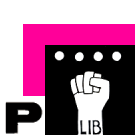User:Kim/reading/Dividing and Sharing
Femke Snelting, Constant Verlag, 2008
synopsis
In "Dividing and Sharing" Femke Snelting argues against the differentiation between content and presentation in the creation of websites.
Snelting introdcues the text with short history of webstandards which arose of lacking compatibility between sites and browsers. An early statement by the W3C claims that with HTML and CSS, content and form are necessarily separated and therefore enable exchange of pure information.
Snelting recognizes a problem in the assumption that the same content supposedly always communicates the same message, it leaves out the act of subjective and situated interpretation.
A distinction between presentation and content can also be found on practical levels: working positions are split in designer, programmer and editor roles.
"Dividing and Sharing" grasps design as more than a mere wrapper, which challenges its methods to go deeper, make visible the relations between levels of design and content and overcome the split in work disciplines.
Femke Snelting ends the text with calling for webdesign as articulation, as a joint work as much as an expression.
Femke snelting works on the intersection of publishing, feminisms, and free software. Spaces she is involved in include Constant (Brussels), The Institute for Technology in the Public Interest and research positions in PhdArts Leiden and MERIAN (Maastricht).
intro
- Webstandards as evolving set of agreements on how digital information should be structured and organized into compatible units
- separate Webs code in HTML for content and CSS for form
- this working premise of W3C states that separating content from presentation facilitates exchange of information (of 'true information' or 'meaning')
- lack of standardization: early on browsers where not compatible, each fighting over their market share, inventing their own mark up
- resulted in problems for designers, content providers and users (impossible to predict what user will see on their screen)
- Call for standardization Acid test introduced competing for compliancy rather than difference between browsers
avoiding tagsoup
- a standardized web is an accessible web (allows for interpretation of web through multiple devices including screen readers)
separating 'content' from presentation
- HTML was designed for semantic markup (not stylistic: < i > got replaced by < em >)
- in W3C approach 'content' is treated as formless matter
- legitimized by the idea that only when information is liberated from any specific instance (device, format ...) it can travel freely between media
- this is a cloud idea, assuming the system itself (on which information/ content is based and travels) is neutral
- basic problem: lies in assumption that the same content, that is presented in different ways, does always communicate the same message (but with changing context and readers, cultures, education, it doesnt)
Divisions of Labour
- standardization (and therefore separation of content and presentation) is also maintained on a labour (practice) level
- designers, programmers, editors
- these divisions facilitate a kind of collaborations that is not concerned with the object of collaboration itself
- but: gets harder to maintain, now that most of the web is built on CMS or other applications
- design decisions need to be made on layout, software and database level at the same time
- template files act as point of contact between designers and developers
- can we shift design work from setting restraints to making possible? from building borders to flexible backbones?
Design as Articulation
- while its convenient to organise web development in clearly separated tasks, if design is more than packaging then work needs to be shared rather than divided
design needs to go deeper than skin
- means to make visible the relations between database architecture, filtering and structure of data itself
- means to acknowledge that each time data appears in different context is a rewriting, reinterpretation (information is never the same)
- for that to happen in meaningful ways, code, content, behaviour and presentation need to intertwine
think about webdesign as the work of articulation (Artikulation, Formulierung, Verständlichkeit, Aussprache)
